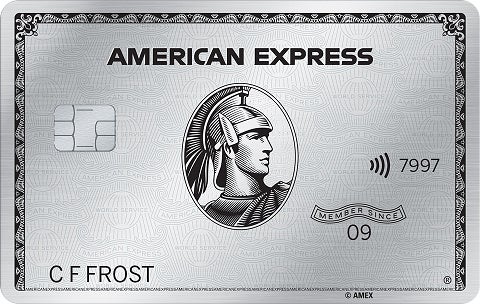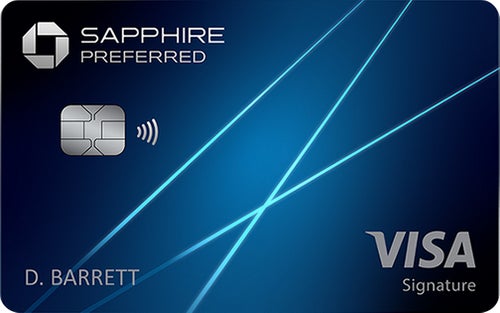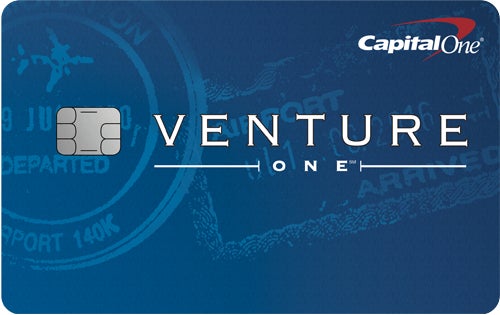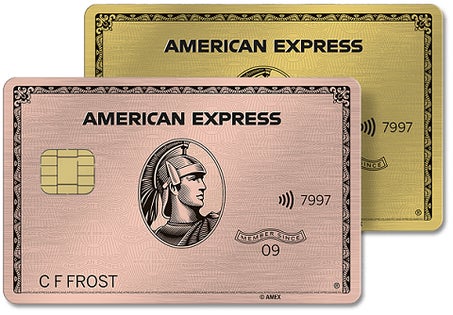































The top credit cards for travel are a great way to earn rewards which can then be used to fund your next trip. They can also provide extra protection to make sure you get where you're going safely, and can help consumers save time and money.
Here you'll find the five best travel cards to take on the road, and some tips on how best to use them.
 card highlights intro bonusEarn 80,000 Membership Rewards? Points after you spend$8,000 on purchases on your new Card in your first 6 months of Card Membership.APRSee Pay Over Time APRrecommended creditExcellent/Goodreward rates
card highlights intro bonusEarn 80,000 Membership Rewards? Points after you spend$8,000 on purchases on your new Card in your first 6 months of Card Membership.APRSee Pay Over Time APRrecommended creditExcellent/Goodreward rates The Platinum Card from American Express is a popular choice for avid travelers. It has a high price tag --$695 -- but it comes with an extensive benefits package that includes numerous annual credits that help soften the blow of its annual fee. Because of that high fee, however, this card should only be considered by consumers who travel enough to take full advantage of everything this card has to offer.
In addition to its travel credits, it also offers a wide variety of travel protections to ensure that you, your family, and your luggage make it safely to your destination. It also provides Global Lounge membership, which gives cardholders access to the largest selection of airport lounges of any credit card.
Here are a few of the many credits and protections the card offers:
And while the benefits are the true draw to the card, its rewards are nothing to sneeze at either.
Pros
Cons

 card highlights intro bonusEarn 60,000 bonus points after you spend$4,000 on purchases in the first 3 months from account opening. That's$750 when you redeem through Chase Ultimate Rewards?.APR21.49% - 28.49% Variablerecommended creditExcellent/Goodreward rates
card highlights intro bonusEarn 60,000 bonus points after you spend$4,000 on purchases in the first 3 months from account opening. That's$750 when you redeem through Chase Ultimate Rewards?.APR21.49% - 28.49% Variablerecommended creditExcellent/Goodreward rates The Chase Sapphire Preferred is a great card to choose for the average traveler. It's rewarding and features lucrative and flexible redemption options, including a 1:1 point transfer rate to Chase's popular travel partners, not to mention its high welcome bonus for new cardholders to take advantage of.
Its rewards program covers plenty of ground, so it's easy to rake in the points. You can then either redeem points for travel through Chase Ultimate Rewards for a 25% point redemption bonus or transfer them to one of Chase's travel partners where you could get an even better value for them. There are also standard redemption options available too, but they won't be as lucrative.
If you can find the right transfer deal to Chase's airline or hotel partners, points could be worth 1.5 cents or more. At that per-point value, the card's cash back equivalent for travel booked through Chase Ultimate Rewards (5x points per dollar) would be 7.5%.
Chase's travel partners include JetBlue, United, Southwest, World of Hyatt, and Marriott Bonvoy, among others. In addition to its strong rewards and redemption options, the card includes a nice selection of travel protections. Cardholders will no doubt find considerable value for its$95 annual fee.
Pros
Cons

 card highlights intro bonusEarn a bonus of 20,000 miles once you spend$500 on purchases within 3 months from account opening, equal to$200 in travelAPR19.99% - 29.99% (Variable)recommended creditExcellent, Goodreward rates
card highlights intro bonusEarn a bonus of 20,000 miles once you spend$500 on purchases within 3 months from account opening, equal to$200 in travelAPR19.99% - 29.99% (Variable)recommended creditExcellent, Goodreward rates The VentureOne offers cardholders considerable value at little cost to their bank account. Use it for every purchase to rake in the miles. Try to book at least one aspect of travel (such as hotel, rental car, and airfare) through Capital One Travel to earn 5x miles per dollar. Miles can then be transferred to Capital One's travel partners or redeemed for recent travel purchases, gift cards, or statement credits.
Capital One, however, doesn't offer very many domestic airline partners, and the transfer rates vary depending on the partner. So, unless you're planning to fly internationally, the best use for your miles will be to redeem for travel purchases made within 90 days.
Redeeming for past travel expenses will ensure a per-mile value of 1 cent. That said, there's no foreign transaction fee to worry about, so if you do plan to travel internationally, you won't incur any additional fees for using the card overseas.
The card also provides an impressive collection of benefits for a no annual fee card, including travel accident and rental car insurance. It even has an intro 0% APR for purchases for 15 months (then 19.74% - 29.74% variable) and an easy-to-reach welcome bonus.
Pros
Cons

 card highlights intro bonusEarn 50,000 American Airlines AAdvantage? bonus miles after spending$2,500 in purchases within the first 3 months of account openingAPR21.24% - 29.99% (Variable)recommended creditExcellent, Goodreward rates
card highlights intro bonusEarn 50,000 American Airlines AAdvantage? bonus miles after spending$2,500 in purchases within the first 3 months of account openingAPR21.24% - 29.99% (Variable)recommended creditExcellent, Goodreward rates The Citi/AAdvantage Platinum Select is a good option for travelers who prefer flying with American Airlines. It features some time-and-money saving perks including priority boarding and your first checked bag, free of charge. It carries an annual fee of$99, but it's waived for the first year.
If that annual fee feels high, there is a lucrative welcome bonus for prospective cardholders to obtain. If you have any trips planned, use the card to fund it to get a head start toward the spending requirement.
However, if American Airlines isn't your go-to airline, take a look at our 6 best airline credit cards to find the one that works best for you.
Pros
Cons

 card highlights intro bonusEarn 60,000 Membership Rewards? Points after you spend$6,000 on eligible purchases with your new Card within the first 6 months of Card Membership.APRSee Pay Over Time APRrecommended creditExcellent/Goodreward rates
card highlights intro bonusEarn 60,000 Membership Rewards? Points after you spend$6,000 on eligible purchases with your new Card within the first 6 months of Card Membership.APRSee Pay Over Time APRrecommended creditExcellent/Goodreward rates As most travelers know, a big aspect of travel is figuring out what kinds of food you want to enjoy while away from home. The American Express Gold Card is the perfect dining companion. It's a rewarding option that offers a nice selection of perks for cardholders.
Not only does it earn 4x points per dollar for dining and at US supermarkets, but it also comes equipped with up to$120 dining credit, split into$10 per month over a year. There's also an up to $120 Uber Cash credit for cardholders to take advantage of. Considering it has an annual fee of$250, using both credits fully would effectively drop it to only$10 a year.
In addition to its credits, it comes with a few -- albeit sparse -- impressive travel protections including a Baggage Insurance Plan and rental car insurance. And for consumers who like to make a statement, the Amex Gold Card is metal and comes in their choice of either Gold or Rose Gold.
Pros
Cons

The best travel card overall is The Platinum Card from American Express. It offers a ton for avid travelers, in both rewards and benefits. It has one of the highest annual fees in the credit card world, however, so it should only be considered by travelers who are able to take full advantage of its many travel credits.
While it may not be a realistic option for some travelers, it's hard not to see its appeal. With the widest airport lounge access of any credit card, numerous travel credits that effectively lower its annual fee to a much more manageable rate, and good rewards coupled with a lucrative welcome bonus, there's a ton of value to be had by consumers who can afford it.
However, for the average traveler, the best option is the Chase Sapphire Preferred. It covers plenty of ground with its rewards and offers flexible and worthwhile redemption options. And although cardholders will need to utilize point transfers to get the best value, it's worth the extra work. Not to mention Chase's travel partners include popular airlines such as United and JetBlue, plus well-known hotel brands including Marriott Bonvoy, World of Hyatt, and IHG.
Card Name | Best For / Annual Fee | Perks |
Platinum Card from Amex | Overall travel /$695 |
|
Chase Sapphire Preferred | General travel /$95 |
|
Citi/AAdvantage Platinum Select | Airline card /$99 |
|
Capital One VentureOne | No annual fee |
|
Amex Gold Card | Dining out /$250 |
|
All of the cards compiled here offer a good value for the traveling consumer. Choose the card that best fits your travel habits.
Choose this card... | If you are... |
The Platinum Card | An avid traveler looking for premium benefits. |
Chase Sapphire Preferred | Someone who travels a few times per year and can use point transfers to get the best value. |
VentureOne Rewards card | An occasional traveler looking for a simple, inexpensive yet rewarding travel card. |
Citi/AAdvantage Platinum card | An occasional traveler who prefers to fly with American Airlines. |
Amex Gold Card | A relatively frequent traveler who loves to eat out while away from home. |
The cards here were compared with others in the travel space and stood out due to their terms, rewards, benefits, and redemption options. The cards here are ahead of the curve when it comes to offering travelers a good value for their money.
They feature useful travel perks and protections, airport lounge access, and some of them include a number of travel credits to lower the cost of trips. They represent the best options for travelers in terms of saving time and money, and getting consumers to their destinations safely.
Yes. None of the cards listed here have a foreign transaction fee, which means you can swipe without fear of incurring additional fees while out of the country.
The Platinum Card from American Express has the highest welcome bonus. It offers new cardholders 80,000 miles for spending$6,000 in the first six months with the card.
However, the VentureOne Rewards card features the easiest-to-reach welcome bonus. New cardholders can earn 20,000 bonus miles after spending$500 within the first three months. Also, keep in mind welcome bonuses are subject to change.
The Platinum Card from American Express features one of the most extensive benefits packages of any card. It has numerous travel credits as well as plenty of travel protections to give consumers added security when traveling. However, with its high annual fee, it's likely not a feasible option for some consumers.
Next in line for travel protections is the Chase Sapphire Preferred. It offers cardholders Trip Cancellation/Interruption Insurance, Baggage Delay Insurance, rental car insurance, and Trip Delay Reimbursement, among others.
The VentureOne Rewards card, despite not asking for an annual fee, comes with Travel Accident Insurance and rental car insurance, while the American Express Gold Card features a Baggage Insurance Plan and rental car insurance.
Unfortunately, Citi removed many of its card protections, so the Citi/AAdvantage Platinum card comes in at the bottom of the pack in terms of additional travel perks.
If none of the travel cards listed above appeal to you, there are a handful of other cards you might consider:
Or, take a look at our travel-related best lists to see how some of the best travel cards stack up against each other:
The 6 best airline credit cards: Earn travel points
The best travel cards for beginners
The 5 best credit cards for airport lounge access: Travel in comfort
The 5 best international travel credit cards: Globetrotter rewards
The best American Airlines credit cards: Earn while you travel
The 5 best Southwest Airlines credit cards: Unlimited tier qualifying points
"Eligibility and Benefit level varies by Card. Terms, Conditions, and Limitations Apply. Please visit americanexpress.com/benefitsguide for more details. Underwritten by Amex Assurance Company."
 Горячие метки:
Наш процесс
1. Финансы
Кредитные карты
Горячие метки:
Наш процесс
1. Финансы
Кредитные карты